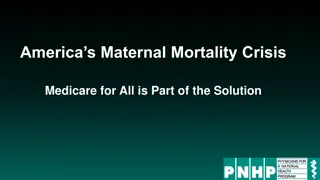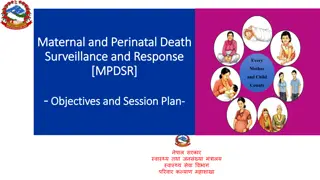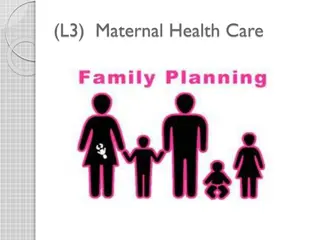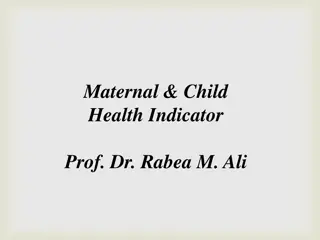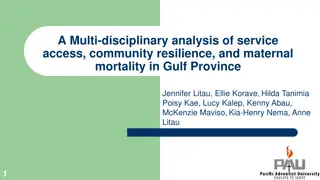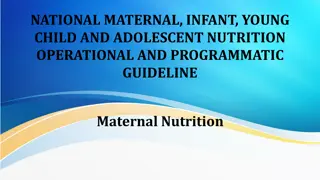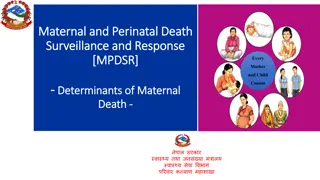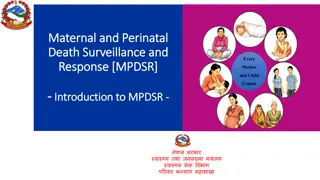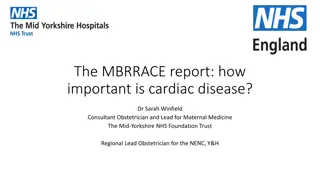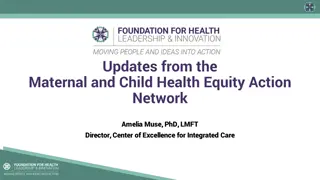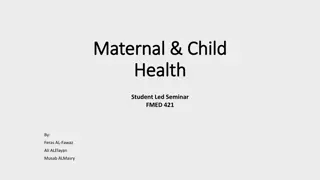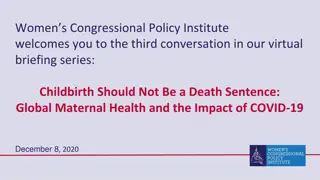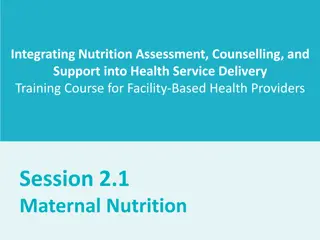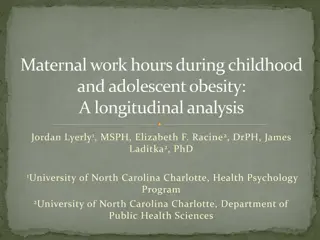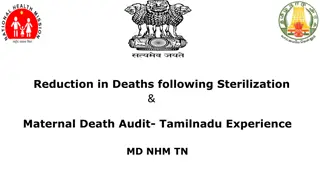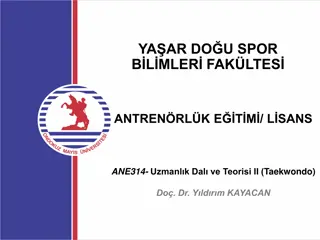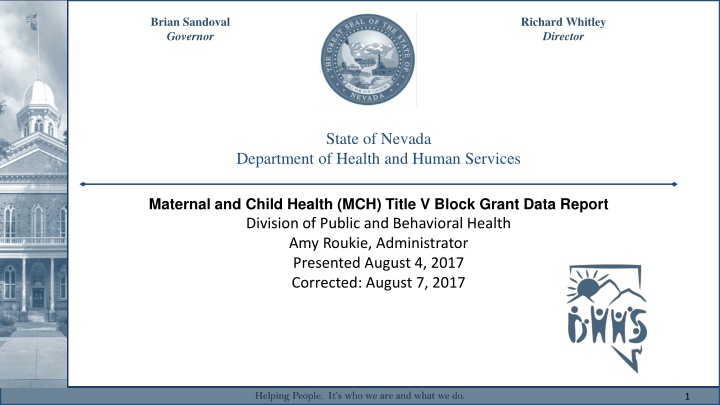
Maternal and Child Health Performance Measurement Data Report
Explore the National Performance Measurement framework for Maternal and Child Health, highlighting key outcome measures and performance indicators. Learn about the significance of the new performance measurement system and trends in maternal and child health outcomes. Data regarding preventive medical visits and breastfeeding rates are analyzed to emphasize the importance of promoting maternal and child health.
Download Presentation

Please find below an Image/Link to download the presentation.
The content on the website is provided AS IS for your information and personal use only. It may not be sold, licensed, or shared on other websites without obtaining consent from the author. If you encounter any issues during the download, it is possible that the publisher has removed the file from their server.
You are allowed to download the files provided on this website for personal or commercial use, subject to the condition that they are used lawfully. All files are the property of their respective owners.
The content on the website is provided AS IS for your information and personal use only. It may not be sold, licensed, or shared on other websites without obtaining consent from the author.
E N D
Presentation Transcript
Brian Sandoval Governor Richard Whitley Director State of Nevada Department of Health and Human Services Maternal and Child Health (MCH) Title V Block Grant Data Report Division of Public and Behavioral Health Amy Roukie, Administrator Presented August 4, 2017 Corrected: August 7, 2017 Helping People. It s who we are and what we do. Helping People. It s who we are and what we do. 1
The National Performance Measurement The National Performance Measurement framework for Maternal and Child Health framework for Maternal and Child Health National Outcome Measures (NOM) Metric for Title V goals as mandated by Title V legislation (e.g., breastfeeding rate, maternal morbidity rate) National Performance Measures (NPM) Metric for a health need that leads or will assist in leading to a specific health outcome of interest and modifiable through Title V activities (e.g., Percent of women with a past year preventive visit) Evidence based/informed Strategies (ESM) Measure of activities and tasks completed to implement a strategy related to a performance measure ( e.g., materials distributed by partners, number of hospitals/birthing locations trained on breastfeeding or baby friendly) Objectives established; data will be included next year because this reporting period is a baseline year Helping People. It s who we are and what we do. 2
Significance of New P Significance of New Performance Measurement erformance Measurement System System Reduce reporting burden Increase flexibility Increase accountability Aims Sharpen focus on national priorities Sharpen measurement Goals Helping People. It s who we are and what we do. 3
Green indicates a positive trend Helping People. It s who we are and what we do. 4
NPM 1 Percent of women with a past year preventive medical visit NPM 1 80 Percent of women with a past year preventive medical visit 70 NPM 1 60 2009 2010 2011 2012 2013 2014 2015 Year Annual Indicator 50 Percent 40 58.61 54.19 55.74 59.02 60.08 61.13 63.98 30 70 70 70 70 70 70 70 Objective 20 10 Percent Change: 2009-2015 0 9.16 2009 2010 2011 2012 2013 2014 2015 Behavioral Risk Factor Surveillance System (BRFSS) 2015 Annual Indicator Objective Linear (Annual Indicator) Helping People. It s who we are and what we do. 5
NPM 4 A) Percent of infants who are ever breastfed NPM 4A 90 88 NPM 4 A Percent of Infants who are ever breastfed 86 2007 2008 2009 2010 2011 2012 2013 Year 84 Percent Annual Indicator 80.5 78.2 80.2 78 80.9 80.09 82.56 82 80 89 89 89 89 89 Objective 78 Percent Change: 2007-2013 76 2.56 2006 2007 2008 2009 2010 2011 2012 2013 2014 Nevada Immunization Survey (NIS) 2013 Annual Indicator Objective Linear (Annual Indicator) Helping People. It s who we are and what we do. 6
NPM 4 B) Percent of infants breastfed exclusively through six months NPM 4B 30 25 Percent of Infants who are breastfed exclusively through six months NPM 4 B 20 2007 2008 2009 2010 2011 2012 2013 Year Percent 15 Annual Indicator 11.9 12.5 11.2 18.7 18 14.75 24.92 10 28 28 28 28 28 Objective 5 Percent Change: 2007-2013 0 109.41 2007 2008 2009 2010 2011 2012 2013 NIS 2013 Annual Indicator Objective Linear (Annual Indicator) Helping People. It s who we are and what we do. 7
National Outcome Measure (NOM) 1 Percent of pregnant women who receive prenatal care beginning in the first trimester NOM 1 80 78 Percent of women who receive prenatal care beginning in the first trimester NOM 1 76 74 2010 2011 2012 2013 2014 2015 Year Annual Indicator 72 65.86 66.78 68.08 68.36 70.74 72.56 Percent 70 68 77.9 77.9 77.9 77.9 77.9 77.9 Objective Percent Change: 2010-2015 66 64 10.17 62 60 58 2010 2011 2012 2013 2014 2015 National Vital Statistics System (NVSS) Annual Indicator Objective Linear (Annual Indicator) Helping People. It s who we are and what we do. 8
NOM 21 Percent of children without health insurance NOM 21 25 20 NOM 21 Percent of children without health insurance 15 2009 2010 2011 2012 2013 2014 2015 Year Percent Annual Indicator 17.96 17.86 16.11 16.58 13.89 9.68 7.63 10 0 0 0 0 0 0 0 Objective 5 Percent Change: 2009-2015 0 2009 2010 2011 2012 2013 2014 2015 -57.52 American Community Survey (ACS) Annual Indicator Objective Linear (Annual Indicator) Helping People. It s who we are and what we do. 9
NOM 22.3 Percent of adolescents, ages 13 through 17, who have received at least one dose of the HPV vaccine (Females) NOM 22.3 F 90 80 Percent of adolescents, ages 13 through 17, who have received at least one dose of the HPV vaccine (female) 70 NOM 22.3 60 2009 2010 2011 2012 2013 2014 2015 Year 50 Percent Annual Indicator 40 38.95 47.44 55.29 62.54 53.76 54.23 72.03 30 80 80 80 80 80 80 80 Objective 20 10 Percent Change: 0 84.93 2009 2010 2011 2012 2013 2014 2015 NIS Annual Indicator Objective Linear (Annual Indicator) Helping People. It s who we are and what we do. 10
Red Indicates attention needed Helping People. It s who we are and what we do. 11
NOM 2 Rate of severe maternal morbidity per 10,000 delivery hospitalizations NOM 2 160 140 Rate of severe maternal morbidity per 10,000 delivery hospitalizations NOM 2 120 2009 2010 2011 2012 2013 2014 Year 100 Annual Indicator Rate 80 103.2 111.85 106.16 127.11 113.3 152.21 60 N/A N/A N/A N/A N/A N/A Objective 40 Percent Change: 2009-2014 20 47.49 0 2009 2010 2011 2012 2013 2014 HCUP State Inpatient Databases (SID) Annual Indicator Linear (Annual Indicator) Helping People. It s who we are and what we do. 12
NOM 11 The rate of infants born with neonatal abstinence syndrome per 1,000 delivery hospitalizations NOM 11 14 12 The rate of infants born with neonatal abstinence syndrome per 1,000 delivery hospitalizations NOM 11 10 2008 2009 2010 2011 2012 2013 2014 Year 8 Rate Annual Indicator 6 3.86 5.61 6.89 8.39 11.04 11.74 12.39 4 N/A N/A N/A N/A N/A N/A N/A Objective 2 Percent Change: 2008-2014 0 220.98 2008 2009 2010 2011 2012 2013 2014 HCUP State Inpatient Databases (SID) Annual Indicator Linear (Annual Indicator) Helping People. It s who we are and what we do. 13
NOM 16.1 Adolescent mortality rate ages 10 through 19 per 100,000 NOM 16.1 45 40 Adolescent mortality rate ages 10 through 19 per 100,000 NOM 16.1 35 2009 2010 2011 2012 2013 2014 2015 Year Annual Indicator 30 25 Rate 36.7 34.2 41.1 29.1 28.8 30.3 38.1 20 N/A N/A N/A N/A N/A N/A N/A Objective 15 Percent Change: 2009-2015 10 3.81 5 Percent Change: 2014-2015 0 2009 2010 2011 2012 2013 2014 2015 25.74 NVSS Annual Indicator Linear (Annual Indicator) Helping People. It s who we are and what we do. 14
State Performance Measures State Performance Measure 2016 Data 2020 Objective SPM 1: Percent of mothers reporting late or no prenatal care 7.9 6.5 SPM 2: Percent of repeat teen births 16.6 15.0 SPM 3: Percent of women who misuse substances during pregnancy 5.5 4.5 Source: Nevada Vital Records Helping People. It s who we are and what we do. 15
Evidence Based or Informed Strategy Measures Evidence Based or Informed Strategy Measures 2016 Data 2020 Objective ESM 1.1: Number of Title V funded partners that disseminate materials to raise awareness of the importance of a well-woman visit coverage benefits, and how to find a provider 7 11 ESM 4.1: Number of hospitals (birthing facilities) receiving training on Baby Steps to Breastfeeding Success or designated as Baby Friendly by Baby Friendly USA 6 11 ESM 6.1: Number of Title V funded partners providing developmental screening in the past year* 16 16 ESM 8.1: Percent of schools that adopt a state physical activity plan/policy* 100 100 *Technical Assistance will be requested from HRSA on ESMs 6.1 and 8.1 Helping People. It s who we are and what we do. 16
Evidence Based or Informed Strategy Measures continued Evidence Based or Informed Strategy Measures 2016 Data 2020 Objective ESM 10.1: Number of Title V partners that conducted activities to promote preventive well visits for youth in the past year 6 10 ESM 11.1: Number of public outreach events to educate the CYSHCN population about how to access and benefits of medical home portal in the past year 8 11 ESM 14.1: Number of pregnant women and new mothers who called the Quitline for assistance in the past 12 months 20 60 ESM 15.1: Number of Title V funded partners that offer assistance with completing insurance applications, including assistance to at-risk populations (e.g. in multiple languages) 7 8 Helping People. It s who we are and what we do. 17
Any questions? Vickie Ives, MA MCAH Section Manager vives@health.nv.gov Margot Chappel, MS Title V MCH Program Manager mchappel@health.nv.gov Helping People. It s who we are and what we do. 18

